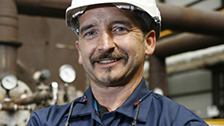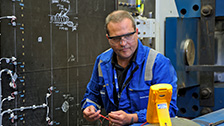Solid particle removal systems are an essential element of modern flue gas cleaning and are critical for securing compliance with applicable emission regulations. Depending on specific project requirements, we offer state-of-the-art fabric filters or electrostatic precipitators for your process.
Fabric filter
Our fabric filters are used to separate the finest particulate pollutants. In addition, they act as a fine filter stage for gaseous acidic substances such as SOx, HCl and HF as well as heavy metals, dioxins, and furans in conjunction with our Circoclean® and FER-DI® system. Clean gas values of 5 mg/Nm³ particle concentration and also significantly below can be achieved permanently.
Applications are possible in the field of waste, sewage sludge and biomass incineration, downstream of boilers fired with refuse derived fuels (RDF), coal or oil, as well as in the industrial sector. Low dust emissions are reliably maintained even with changing fuel qualities and load conditions.
The fabric filters are usually designed with several chambers so that the plant components can be easily separated from the flue gas flow for inspection and maintenance purposes. The particle-laden flue gas enters the filter chamber from below via the raw gas inlet. The low inflow velocity promotes the pre-separation of coarse particles and ensures uniform flow distribution. The gas flows through the filter hoses, in which the solid particles stick, from the outside to the inside. The filter cake that forms on the hoses is removed by means of compressed air cleaning, falls into the filter funnels, and can be discharged.
We have a reference list of more than 50 fabric filters installed in different types of plants worldwide.
Low-pressure pulse jet (LPPJ) fabric filter
For installations of a certain minimum size, we usually use our low-pressure pulse-jet (LPPJ) fabric filter.
The main advantage of this type of filter is that the low purge air supply pressure is less than 1 bar (g), as opposed to 2 to 7 bar (g) for conventional systems, which means that significantly less energy is required for the cleaning process. In addition, the required compressed air can be generated with a simple rotary blower.
High-pressure pulse jet (HPPJ) fabric filter
For smaller flue gas volumes, we typically use our high-pressure pulse-jet (HPPJ) fabric filter which in this case can be constructed more cost-effectively from small chambers.
Electrostatic precipitator
With our proven electrostatic precipitators, we can remove particulate matter from the flue gas and achieve clean gas values below 8 mg/Nm³. Applications are possible in sewage sludge, waste and biomass incineration plants, downstream of steam generators fired with refuse derived fuels (RDF), coal or oil, and in the industrial sector.
In mono-sludge incineration plants, electrostatic precipitators usually form the first stage of flue gas cleaning downstream of the boiler. The pre-separation of particulate matter in the electrostatic precipitator ensures low-pollutant ash, which serves as the basis for the phosphorus recovery required by law.
After the flue gas enters the electrostatic precipitator, dust particles are negatively charged using spray electrodes (cathodes). The particles pass through a strong electric field where they are attracted by positively charged collecting electrodes (anodes) and stick. Periodic tapping cleans the precipitation electrodes, causing attracted dust to fall into the ash hoppers of the electrostatic precipitator. The gas cleaned of dust particles leaves the electrostatic precipitator via the clean gas hood.
We have over 100 electrostatic precipitator references worldwide.




